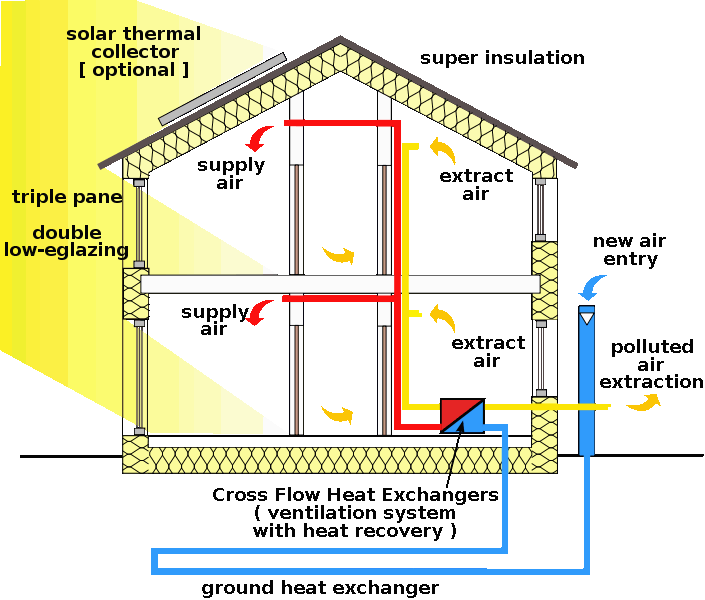|


Concept
originators: Professors Bo Adamson, Sweden, and Wolfgang Feist,
Germany
IS
PASSIVHAUS RELEVANT IN THE UK?
There is growing interest in Passivhaus in the UK. The high standards of energy efficiency achieved can meet government targets for lower carbon homes. There is also a marketing advantage since the homes adopt an inclusive, adaptable design which require little to no
energy for heating or cooling, thus lowering energy bills. Doors, windows, boilers and other equipment used in Passivhaus will soon be manufactured by UK companies which will make installations cost effective. The health benefits for using Passivhaus is also remarkable since ventilation is provided by quiet mechanical ventilation systems which allow a high quality of fresh air to circulate without opening windows and reducing ones comfort level.
The
energy-saving German design methodology PassivHaus offers a route to achieving the UK’s zero-carbon housing
goals. This is pressing issue due to the government’s aim for all new housing to be zero-carbon by 2016.
PassivHaus guidelines in the UK (see page 61) as more and more architects and clients push to dramatically cut carbon emissions.
PassivHaus is based on enhancing building envelopes to reduce heating loads to the point that a conventional heating system can be eliminated. Developed from a German- Swedish academic collaboration in 1988, the first PassivHaus buildings were completed in 1991 in Darmstadt,
Germany, the same city in which the PassivHaus Institute was founded.
Five years
on over 9,500 PassivHaus buildings have been realised in Germany, over 2,500 in Austria, and approximately 12,500 worldwide. Gavin Hodgson of the BRE estimates that the number of PassivHaus schemes in the UK is in the low hundreds. No exact figures are available because no UK building has attained PassivHaus designation yet, perhaps partly due to the £2,000 price tag for certification.
PassivHaus standards are roughly equivalent to Code for Sustainable Homes level four, two levels below the zero-carbon level six. The design heat load of a PassivHaus must be less than 15kWh/m2/year - which equals the heat that can be transported by the minimum required mechanical ventilation. Joints between materials and components and all service penetrations must be sealed.
THE
CODE FOR SUSTAINABLE HOUSING
To achieve Code Level 4 new homes must make a 44% improvement in energy efficiency against building regulations. Passivhaus principles will help developers to achieve this standard. Hastoe Housing Association, Sustainable Homes parent company are developing a mixed tenure Passivhaus scheme of 14 houses that will achieve Code Level 4.
The Code for Sustainable Homes is a government mechanism to drive sustainability in new build homes. To meet Code requirements there are mandatory requirements in energy efficiency. These requirements get more demanding the further up the Code Levels, until at Code Level 6 a home is required to be entirely carbon neutral.
All new homes will have to be built to carbon neutral standards by 2016. Already 2/3rds of local authorities require Code for Sustainable Homes levels for all new housing. All government funded schemes, are required to meet Code Level 3.
The Mayor of London confirmed in April 2011 that any new housing in London
must meet Code 4.
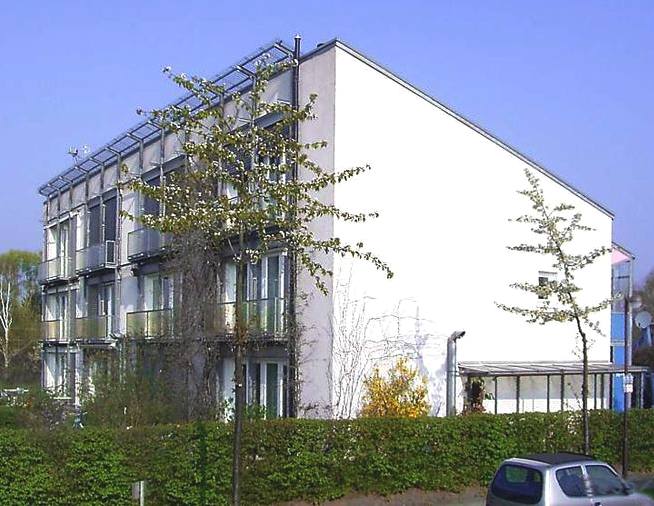
Concept
Passivhaus Darmstadt Kranichstein Fruehling
2006
PASSIVHAUS
HISTORY
The term passive house (Passivhaus in German) refers to the rigorous, voluntary, Passivhaus standard for energy efficiency in a building, reducing its ecological footprint. It results in ultra-low energy buildings that require little energy for space heating or cooling. A similar standard, MINERGIE-P, is used in Switzerland. The standard is not confined to residential properties; several office buildings, schools, kindergartens and a supermarket have also been constructed to the standard. Passive design is not an attachment or supplement to architectural design, but a design process that is integrated with architectural design. Although it is mostly applied to new buildings, it has also been used for refurbishments.
Estimates of the number of Passivhaus buildings around the world in late 2008 ranged from 15,000 to 20,000 structures. As of August 2010, there were approximately 25,000 such certified structures of all types in Europe, while in the United States there were only 13, with a few dozens more under construction. The vast majority of passive structures have been built in German-speaking countries and Scandinavia.
The Passivhaus standard originated from a conversation in May 1988 between Professors Bo Adamson of Lund University, Sweden, and Wolfgang Feist of the Institut für Wohnen und Umwelt (Institute for Housing and the Environment, Germany). Their concept was developed through a number of research projects, aided by financial assistance from the German state of
Hessen.
FIRST EXAMPLES
The eventual building of four row houses (terraced houses or town homes), was designed for four private clients by the architectural firm of professors Bott, Ridder and Westermeyer. The first Passivhaus residences were built in Darmstadt, Germany in 1990, and occupied by the clients the following year.
Further implementation and councils
In September 1996 the Passivhaus-Institut was founded, also in Darmstadt, to promote and control the standards. Since then, thousands of Passivhaus structures have been built, to an estimated 25,000+ as of 2010. Most are located in Germany and Austria, with others in various countries worldwide.
After the concept had been validated at Darmstadt, with space heating 90% less than required for a standard new building of the time, the Economical Passive Houses Working Group was created in 1996. This group developed the planning package and initiated the production of the innovative components that had been used, notably the windows and the high-efficiency ventilation systems. Meanwhile further passive houses were built in Stuttgart (1993), Naumburg, Hesse, Wiesbaden, and Cologne (1997).
The products developed for the Passivhaus standard were further commercialised during and following the European Union sponsored CEPHEUS project, which proved the concept in five European countries over the winter of 2000–2001. In North America the first Passivhaus was built in Urbana, Illinois in 2003, and the first to be certified was built in 2006 near Bemidji, Minnesota in Camp Waldsee of the German Concordia Language Villages.
The first US passive retrofit project was certified in July 2010: the remodeled 2,400 sf craftsman O'Neill house in Sonoma, California.
The world's first standardised passive prefabricated house was built in Ireland in 2005 by Scandinavian Homes, a Swedish company that has since built more passive houses in England and Poland.

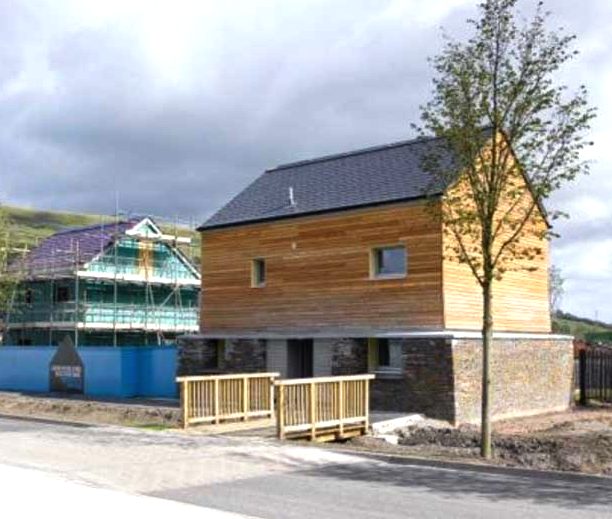
A
nice example of a 'Passivhaus'
built in Wales, UK
PRESENT DAY
Estimates on the number of passive houses around the world range from 15,000 to 20,000. The vast majority have been built in German-speaking countries or Scandinavia. The first certified passive house in the Antwerpen region of Belgium, was built in 2010. The city of Heidelberg in Germany recently gave birth to the Bahnstadt project, which is seen as the world's largest passive house building areas. A company in Qatar is planning the country's first passivhaus in 2013, the first in the region.
STANDARDS
While some techniques and technologies were specifically developed for the Passive House standard, others, such as
super-insulation, already existed, and the concept of passive solar building design dates back to antiquity. There was also other previous experience with low-energy building standards, notably the German Niedrigenergiehaus (low-energy house) standard, as well as from buildings constructed to the demanding energy codes of Sweden and Denmark.
The Passivhaus standard for central Europe requires that the building fulfills the following requirements:
The building must be designed to have an annual heating demand as calculated with the Passivhaus Planning Package of not more than 15 kWh/m² per year (4746 btu/ft² per year) in heating and 15 kWh/m² per year cooling energy OR to be designed with a peak heat load of 10W/m².
Total primary energy (source energy for electricity and etc.) consumption (primary energy for heating, hot water and electricity) must not be more than 120 kWh/m² per year (3.79 × 104 btu/ft² per year).
The building must not leak more air than 0.6 times the house volume per hour (n50 ≤ 0.6 / hour) at 50 Pa (N/m²) as tested by a blower door
RECOMMENDATIONS
Further, the specific heat load for the heating source at design temperature is recommended, but not required, to be less than 10 W/m² (3.17 btu/h.ft² per hour).
These standards are much higher than houses built to most normal building codes. For comparisons, see the international comparisons section below.
National partners within the 'consortium for the Promotion of European Passive Houses' are thought to have some flexibility to adapt these limits locally.
Space heating requirement
By achieving the Passivhaus standards, qualified buildings are able to dispense with conventional heating systems. While this is an underlying objective of the Passivhaus standard, some type of heating will still be required and most Passivhaus buildings do include a system to provide supplemental space heating. This is normally distributed through the low-volume heat recovery ventilation system that is required to maintain air quality, rather than by a conventional hydronic or high-volume forced-air heating system, as described in the space heating section below.
BUILD COSTS
In Passivhaus buildings, the cost savings from dispensing with the conventional heating system can be used to fund the upgrade of the building envelope and the heat recovery ventilation system. With careful design and increasing competition in the supply of the specifically designed Passivhaus building products, in Germany it is now possible to construct buildings for the same cost as those built to normal German building standards, as was done with the Passivhaus apartments at Vauban, Freiburg. On average, however, passive houses are still up to 14% more expensive upfront than conventional buildings.
Evaluations have indicated that while it is technically possible, the costs of meeting the Passivhaus standard increase significantly when building in Northern Europe above 60° latitude. European cities at approximately 60° include Helsinki in Finland and Bergen in Norway. London is at 51°; Moscow is at 55°.
These facts have led a number of architects to construct buildings that use the ground under the building for massive heat storage to shift heat production from the winter to the summer. Some buildings can also shift cooling from the summer to the winter. At least one designer uses a passive thermosiphon carrying only air, so the process can be accomplished without expensive, unreliable machinery. (See also Annualized geo solar)
DESIGN & CONSTRUCTION
Achieving the major decrease in heating energy consumption required by the standard involves a shift in approach to building design and construction. Design may be assisted by use of the 'Passivhaus Planning Package' (PHPP), which uses specifically designed computer simulations.
To achieve the standards, a number of techniques and technologies are used in combination:
Passive solar design and landscape
Passive solar building design and energy-efficient landscaping support the Passive house energy conservation and can integrate them into a neighborhood and environment. Following passive solar building techniques, where possible buildings are compact in shape to reduce their surface area, with principal windows oriented towards the equator - south in the northern hemisphere and north in the southern hemisphere - to maximize passive solar gain. However, the use of solar gain, especially in temperate climate regions, is secondary to minimizing the overall house energy requirements. In climates and regions needing to reduce excessive summer passive solar heat gain, whether from direct or reflected sources, Brise soleil, trees, attached pergolas with vines, vertical gardens, green roofs, and other techniques are implemented.
Passive houses can be constructed from dense or lightweight materials, but some internal thermal mass is normally incorporated to reduce summer peak temperatures, maintain stable winter temperatures, and prevent possible overheating in spring or autumn before the higher sun angle "shades" mid-day wall exposure and window penetration. Exterior wall color, when the surface allows choice, for reflection or absorption insolation qualities depends on the predominant year-round ambient outdoor temperature. The use of deciduous trees and wall trellised or self attaching vines can assist in climates not at the temperature extremes.
SUPER INSULATION
Passivhaus buildings employ superinsulation to significantly reduce the heat transfer through the walls, roof and floor compared to conventional buildings. A wide range of thermal insulation materials can be used to provide the required high R-values (low U-values, typically in the 0.10 to 0.15 W/(m².K) range). Special attention is given to eliminating thermal bridges.
A disadvantage resulting from the thickness of wall insulation required is that, unless the external dimensions of the building can be enlarged to compensate, the internal floor area of the building may be less compared to traditional construction.
In Sweden, to achieve passive house standards, the insulation thickness would be 335 mm (about 13 in) (0.10 W/(m².K)) and the roof 500 mm (about 20 in) (U-value 0.066 W/(m².K)).
ADVANCED WINDOW TECHNOLOGY
To meet the requirements of the Passivhaus standard, windows are manufactured with exceptionally high R-values (low U-values, typically 0.85 to 0.70 W/(m².K) for the entire window including the frame). These normally combine triple-pane insulated glazing (with a good solar heat-gain coefficient, low-emissivity coatings, sealed argon or krypton gas filled inter-pane voids, and 'warm edge' insulating glass spacers) with air-seals and specially developed thermally broken window frames.
In Central Europe and most of the United States, for unobstructed south-facing Passivhaus windows, the heat gains from the sun are, on average, greater than the heat losses, even in mid-winter.
AIRTIGHTNESS
Building envelopes under the Passivhaus standard are required to be extremely airtight compared to conventional construction. This is achieved through air barriers, careful sealing of every construction joint in the building envelope, and sealing of all service penetrations.
Airtightness minimizes the amount of warm — or cool — air that can pass through the structure, enabling the mechanical ventilation system to recover the heat before discharging the air externally.
VENTILATION
Use of passive natural ventilation is an integral component of passive house design where ambient temperature is conducive — either by singular or cross ventilation, by a simple opening or enhanced by the stack effect from smaller ingress with larger egress windows and/or clerestory-operable skylight.
When ambient climate is not conducive, mechanical heat recovery ventilation systems, with a heat recovery rate of over 80% and high-efficiency electronically commutated motors (ECM), are employed to maintain air quality, and to recover sufficient heat to dispense with a conventional central heating system. Since passively designed buildings are essentially air-tight, the rate of air change can be optimized and carefully controlled at about 0.4 air changes per hour. All ventilation ducts are insulated and sealed against leakage.
Some Passivhaus builders promote the use of earth warming tubes (typically ≈200 mm (~7,9 in) diameter, ≈40 m (~130 ft) long at a depth of ≈1.5 m (~5 ft)). These are buried in the soil to act as earth-to-air heat exchangers and pre-heat (or pre-cool) the intake air for the ventilation system. In cold weather the warmed air also prevents ice formation in the heat recovery system's heat exchanger. Concerns about this technique have arisen in some climates due to problems with condensation and mold.
Alternatively, an earth to air heat exchanger can use a liquid circuit instead of an air circuit, with a heat exchanger (battery) on the supply air.
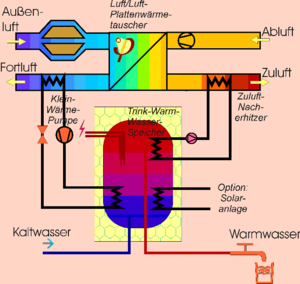
SPACE HEATING
In addition to using passive solar gain, Passivhaus buildings make extensive use of their intrinsic heat from internal
sources - such as waste heat from lighting, white goods (major appliances) and other electrical devices (but not dedicated
heaters) - as well as body heat from the people and other animals inside the building. This is due to the fact that people, on average, emit heat equivalent to 100 watts each of radiated thermal energy.
Together with the comprehensive energy conservation measures taken, this means that a conventional central heating system is not necessary, although they are sometimes installed due to client skepticism.
Instead, Passive houses sometimes have a dual purpose 800 to 1,500 watt heating and/or cooling element integrated with the supply air duct of the ventilation system, for use during the coldest days. It is fundamental to the design that all the heat required can be transported by the normal low air volume required for ventilation. A maximum air temperature of 50 °C (122 °F) is applied, to prevent any possible smell of scorching from dust that escapes the filters in the system.
The air-heating element can be heated by a small heat pump, by direct solar thermal energy, annualized geothermal solar, or simply by a natural gas or oil burner. In some cases a micro-heat pump is used to extract additional heat from the exhaust ventilation air, using it to heat either the incoming air or the hot water storage tank. Small wood-burning stoves can also be used to heat the water tank, although care is required to ensure that the room in which stove is located does not overheat.
Beyond the recovery of heat by the heat recovery ventilation unit, a well designed Passive house in the European climate should not need any supplemental heat source if the heating load is kept under 10W/m².
Because the heating capacity and the heating energy required by a passive house both are very low, the particular energy source selected has fewer financial implications than in a traditional building, although renewable energy sources are well suited to such low loads.
LIGHTING and ELECTRICAL APPLIANCES
To minimize the total primary energy consumption, the many passive and active
day-lighting techniques are the first daytime solution to employ. For low light level days,
non day lit spaces, and nighttime; the use of creative-sustainable lighting design using low-energy sources such as 'standard voltage' compact fluorescent lamps and solid-state lighting with Light-emitting diode-LED lamps, organic light-emitting diodes, and PLED - polymer light-emitting diodes; and 'low voltage' electrical filament-Incandescent light bulbs, and compact Metal halide, Xenon and Halogen lamps, can be used.
Solar powered exterior circulation, security, and landscape lighting - with photovoltaic cells on each fixture or connecting to a central Solar panel system, are available for gardens and outdoor needs. Low voltage systems can be used for more controlled or independent illumination, while still using less electricity than conventional fixtures and lamps. Timers, motion detection and natural light operation sensors reduce energy consumption, and light pollution even further for a Passivhaus setting.
Appliance consumer products meeting independent energy efficiency testing and receiving Ecolabel certification marks for reduced electrical-'natural-gas' consumption and product manufacturing carbon emission labels are preferred for use in Passive houses. The ecolabel certification marks of Energy Star and EKOenergy are examples.

PASSIVHAUS TRAITS
Typically, passive houses feature:
Fresh, clean air: Note that for the parameters tested, and provided the filters (minimum F6) are maintained, HEPA quality air is provided. 0.3 air changes per hour (ACH) are recommended, otherwise the air can become "stale" (excess CO2, flushing of indoor air pollutants) and any greater, excessively dry (less than 40% humidity). This implies careful selection of interior finishes and furnishings, to minimize indoor air pollution from VOC's (e.g., formaldehyde). This can be counteracted somewhat by opening a window for a very brief time, by plants, and by indoor fountains.
Because of the high resistance to heat flow (high R-value insulation), there are no "outside walls" which are colder than other walls.
Homogeneous interior temperature: it is impossible to have single rooms (e.g. the sleeping rooms) at a different temperature from the rest of the house. Note that the relatively high temperature of the sleeping areas is physiologically not considered desirable by some building scientists. Bedroom windows can be cracked open slightly to alleviate this when necessary.
Slow temperature changes: with ventilation and heating systems switched off, a passive house typically loses less than 0.5 °C (1 °F) per day (in winter), stabilizing at around 15 °C (59 °F) in the central European climate.
Quick return to normal temperature: opening windows or doors for a short time has only a limited effect; after aperatures are closed, the air very quickly returns to the "normal" temperature.
INTERNATIONAL COMPARISONS
In the United States, a house built to the Passive House standard results in a building that requires space heating energy of 1 BTU per square foot (11 kJ/m²) per heating degree day, compared with about 5 to 15 BTUs per square foot (56-170 kJ/m²) per heating degree day for a similar building built to meet the 2003 Model Energy Efficiency Code.
This is between 75 and 95% less energy for space heating and cooling than current new buildings that meet today's US energy efficiency codes. The Passivhaus in the German-language camp of Waldsee, Minnesota was designed under the guidance of architect Stephan Tanner of INTEP, LLC, a Minneapolis- and Munich-based consulting company for high performance and sustainable construction. Waldsee BioHaus is modeled on Germany’s Passivhaus standard: beyond that of the U.S. LEED standard which improves quality of life inside the building while using 85% less energy than a house built to Minnesota building codes.
In the United Kingdom, an average new house built to the Passive House standard would use 77% less energy for space heating, compared to the circa-2006 Building Regulations.
In Ireland, it is calculated that a typical house built to the Passive House standard instead of the 2002 Building Regulations would consume 85% less energy for space heating and cut space-heating related carbon emissions by 94%.
ZERO ENERGY BUILDINGS
A net zero-energy building (ZEB) is a building that over a year does not use more energy than it generates. The first 1979 Zero Energy Design building used passive solar heating and cooling techniques with air-tight construction and super insulation. A few ZEB’s fail to fully exploit more affordable conservation technology and all use onsite active renewable energy technologies like photovoltaic to offset the building's primary energy consumption. Passive House and ZEB are complementary synergistic technology approaches, based on the same physics of thermal energy transfer and storage: ZEBs drive the annual energy consumption down to 0 kWh/m² from the already low PassivHaus criteria of 120 kWh/m² with help from on-site renewable energy sources. Energy Plus houses are similar to both PassivHaus and ZEB but emphasize the production of more energy per year than they consume, e.g., annual energy performance of -25 kWh/m² is an Energy Plus house.
TROPICAL CLIMATE NEEDS
In a tropical climate, it could be helpful for ideal internal conditions to use Energy Recovery Ventilation instead of Heat Recovery Ventilation to reduce the humidity load of ventilation on the mechanical dehumidification system. Although dehumidifiers might be used, heat pump hot water heaters also will act to cool and condense interior humidity (where it can be dumped into drains ) and dump the heat into the hot water tank. Passive cooling, solar air conditioning, and other solutions in passive solar building design need to be studied to adapt the Passive house concept for use in more regions of the world.
There is a certified Passive House in the hot and humid climate of Lafayette, Louisiana, USA, which uses Energy Recovery Ventilation and an efficient one ton air-conditioner to provide cooling and dehumidification.
Solar access is a very important factor in any design of a passive house as it allows the structure to use the solar energy to heat and lighten the space naturally, replace electrical water heaters with solar-energy-based water heaters, in addition to providing a healthy environment inside the building.
JOIN
IN
Join
us in the drive for a green economy. Email
or call to register your interest in these exciting sustainable
developments for a better Britain.
COMMENT
The
Passivhaus system offers one possible solution to reducing heating
costs, but it could be an expensive solution. Our main concern is that
the extensive ground preparation works needed for heat exchange raise
the build cost, compared to the Utopia Tristar system, where no ground
(works) preparation is needed. See the diagram below, a simplified flow
diagram to illustrate how simple the integrated solar conservatory
collects and concentrates heat, which is then stored in special water
tanks that sequentially release heat to room radiators (or a ducted heat
exchange distribution system) and for bathing, etc, as and when
required.
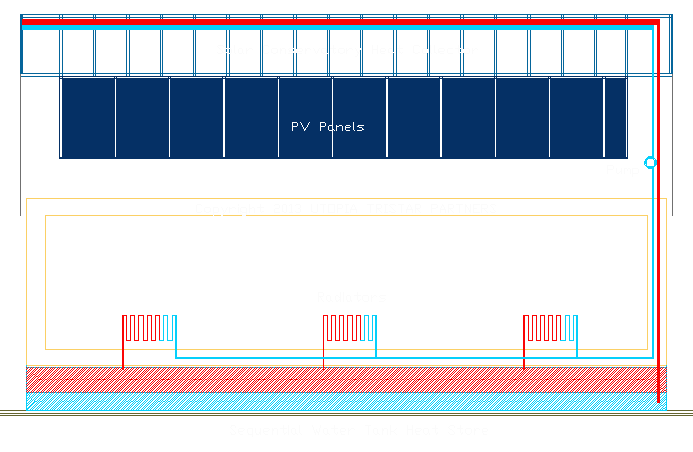
LINKS
http://www.sustainablehomes.co.uk/case-studies-of-successful-code-for-sustainable-homes-projects
http://www.energysavingtrust.org.uk/Generating-energy/Getting-money-back/Renewable-Heat-Incentive-RHI
http://en.wikipedia.org/wiki/Passive_house
American
Passive House Network
Passive
House Institute U.S.
Passive
House Alliance United States
Passive
House Institute New Zealand
Passivhaus
Germany
Passivhaus
Institut
Umbau
zum Passivhaus
Passivhaus
Infos
Passivhaus.org
History
of the Passivhaus
CEPHEUS
Final Report (5MB) Major European Union research project. Technical
report on as-built thermal performance.
Passive
houses in Sweden: Experiences from design and construction phase
Lund University (5MB)
Passive
House for the Olympic Winter Games 2010
Passive
and Low Energy Architecture Conference Munich 2013
|




